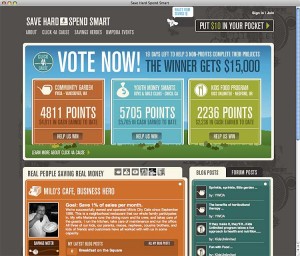Here are some of the major innovations and significant online/technology trends that financial marketers should watch in the coming years. (Please note: This is by no means intended to be a comprehensive or definitive list.)
What do you think will be a major trend shaping financial marketing in 2010 and beyond? Please leave your thoughts and comments below.
1. The Megasite
The once-simple microsites financial institutions made for their marketing campaigns have ballooned into massive undertakings. Look at the monstrous scale of Umpqua’s “Save Hard, Spend Smart” website or GTE Federal Credit Union’s “U-22” site. These are major undertakings with multiple layers and dozens of pages.
Nowadays, creating an immersive and engaging online experience requires a lot more work. Figuring out how to integrate the array of social media platforms — Twitter, YouTube, Facebook — is a struggle.
Megasites will be a continuing trend through 2010 and beyond. Just be sure to create brand/image synergy between your promotional subsite(s) and your primary website.
2. Financial Edutainment
Financial education will have to become a lot more entertaining and interactive in 2010 and beyond. Check out BofA’s “Morris on Campus,” or their comic attempt with “Mo Rocca on Banking,” to get a good idea for how high the bar has been raised.

Many credit unions are using “savings challenges” to stimulate interest in lessons of thrift. Umpqua’s “Save Hard, Spend Smart” initiative has a number of financial education components. ING DIRECT’s “Planet Orange” is another great example. And Nevada State Bank hired the world’s most celebrated conman to create a series of online educational videos about fighting identity theft and financial fraud.
3. New Channels for Customer Service
Live online chat has been around for a few years, but financial institutions are deploying it at a quickened pace. With instant online chat, you can address people’s questions and concerns right at the point-of-sale, transforming an otherwise static, one-directional marketing tool into an interactive sales/service experience. Expect to see a continuing increase in the uptake of live chat.
BofA was the first bank to provide customer service via Twitter. Wells Fargo, Wachovia and others have joined in. Now, BofA is getting serious. They have a whole dedicated Twitter team, and a new fancy CMS tool to manage their Twitter-based customer service interactions.
But you don’t need to be on Twitter to provide next-generation customer support. For example, you can text “unhappy” to the State Bank of India and they guarantee they will respond to your complaint within 48 hours.

Why Industry Cloud for Banking?
PwC’s Industry Cloud for Banking helps deliver personalized products and services that today’s customers expect.

Are You Ready for a Digital Transformation?
Unlock the potential of your financial institution's digital future with Arriba Advisors. Chart a course for growth, value and superior customer experiences.
4. Online PFM
Few things have made as big a difference to consumers over the last couple years — from a practical perspective — as the introduction of online Personal Financial Management tools. Online PFM is like a more robust, next-gen version of desktop applications like Quicken, enabling consumers to track spending and manage their money. One big feature is that many PFM solutions aggregate information from multiple financial institutions in a single view. Other PFM features can include financial advice, community features, and visualizations.
 Companies offering online PFM services like Mint, Geezeo and Jwaala have taken the financial industry by storm. Now, white label players are coming into the market, and some banks are even deploying their own proprietary PFM solutions. Any financial institution that underestimates the significance of the PFM trend is making a big mistake.
Companies offering online PFM services like Mint, Geezeo and Jwaala have taken the financial industry by storm. Now, white label players are coming into the market, and some banks are even deploying their own proprietary PFM solutions. Any financial institution that underestimates the significance of the PFM trend is making a big mistake.
5. “We’re Listening”
 Financial institutions who believe that their primary purpose on the social web is to listen will solicit feedback — both the good and the bad — from the public, and do so publicly. They are out there on the web saying, “Go ahead and tell us what you think.”
Financial institutions who believe that their primary purpose on the social web is to listen will solicit feedback — both the good and the bad — from the public, and do so publicly. They are out there on the web saying, “Go ahead and tell us what you think.”
HSBC’s FirstDirect, with a website displaying good and bad customer feedback, is one of the most notable examples. HSBC also invited folks to speak up on its “Soapbox.” There’s also Westpac in Australia with its “Truth Pod.” USAA hosts “What’s on Your Mind.” And United FCU created “Matter” so Gen-Y could rant and complain.

6. Proprietary Applications
ING DIRECT was probably the first to introduce an API for Twitter with its “Fee Tweeter” application. And Vantage Credit Union’s “Tweet My Money” is a fully-proprietary innovation that allows people to access account information and make transfers via Twitter.
Chase hosted a contest for charitable donations using its own proprietary Facebook app. And SunTrust recently launched its “Swap A Solid” Facebook application enabling people to trade durable goods with one another.
Netbanker.com has written extensively about iPhone innovations in the financial industry. Check out their archive of iPhone articles. They even produced a comprehensive (and meaty) report.
7. Remote Deposit Capture
Whether by mobile phone (like USAA and WV United FCU), scanner (like Jefferson Financial) or even the honor system, enabling people to make deposits remotely will be a big trend from now until checks go away.
8. Online Reviews, Q&A Forums
Allowing actual users of your products and services to publicly comment on them at your website is Web 2.0 at its purest: open, honest, transparent and accountable. America First Credit Union was one of the first financial institutions in the country to let people rate and review its products. You can take it a step further and let people ask and answer questions, as USAA has with its “Member 2 Member” forums.

How Banks Are Fortifying Their Data Against Increasing Cyber Threats
This webinar from Veeam will detail the value of working together across your organization to be better prepared in cyber defense and response readiness.
Read More about How Banks Are Fortifying Their Data Against Increasing Cyber Threats

The Power of Localized Marketing in Financial Services
Learn how to enhance your brand’s local visibility, generate more leads, and attract more customers, all while adhering to industry regulations and compliance.
Read More about The Power of Localized Marketing in Financial Services
9. Online Contests for Charity
 Financial institutions will wake up in 2010 and realize they can be making engaging online promotions out of their charitable donations. Just look at what Servus Credit Union and Wells Fargo have done. None of this was really feasible before social media tools came along. And you don’t need to give away a lot of money, as one credit union proved with its $2,000 scholarship giveaway.
Financial institutions will wake up in 2010 and realize they can be making engaging online promotions out of their charitable donations. Just look at what Servus Credit Union and Wells Fargo have done. None of this was really feasible before social media tools came along. And you don’t need to give away a lot of money, as one credit union proved with its $2,000 scholarship giveaway.
10. UGC
While nothing new, UGC (short for “User-Generated Content”) will continue to be one of the primary ways financial institutions integrate social media tactics into their marketing mix. Financial institutions will host blogger contests, photo contests, “my ugly [fill-in-the-blank]” contests and make-your-own TV contests. Just be careful that you don’t “salt the mine” with your own submissions.
11. Making “Community” the focus of Online Communities
Instead of building self-serving online social media communities, some financial institutions are trying to help improve their real, offline communities. Check out what this bank and these two credit unions did to help their communities during the recession. To see this strategy lived out to its fullest, take a look at the myriad of ways Caja Navarra supports its communities online. This Spanish bank will put most non-profits (and not-for-profit credit unions) to shame.
12. Automatic Savings Plans
BofA was one of the first to introduce automatic savings programs, with its “Keep The Change” project. Then there was Wachovia’s “Way 2 Save.” Citizens Bank recently introduced “GoalTrack Savings,” a goal-based savings account with rewards. Third-party products like Bancvue’s “Kasasa” are integrating automatic savings options. You can even include automatic savings into your auto loans.







